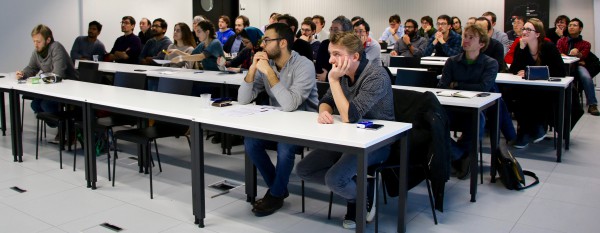MARVEL Junior Seminar — May 2017
The MARVEL Junior Seminars aim to intensify interactions between the MARVEL Junior scientists belonging to different research groups located at EPFL. The EPFL community interested in MARVEL research topics is very welcome to attend. We believe that these events will be central for establishing a vibrant community.
Each seminar consists of two presentations of 25 minutes each, allowing to present on a scientific question in depth, each presentation being followed by 10 minutes for discussion. The discussion is facilitated and timed by the chairperson of the day whose mission is to ensure active lively interactions between the audience and the speakers.
Pizza is served as of 11:45 in the MED hall (floor 0), and after the seminar at 13:30 you are cordially invited for coffee and dessert to continue discussion with the speakers.

MARVEL Junior Seminar Organizing Committee — Ariadni Boziki, Francesco Ambrosio, Fernando Gargiulo, Sandip De, Davide Tiana, Michele Pizzochero, Quang Van Nguyen and Nathalie Jongen
Check the list of the next MARVEL Junior Seminars in 2017 here.
Abstract — Probabilistic analysis of molecular motifs - Piero Gasparotto
A key step in rationalizing the properties of a material is to recognize and understand its structural patterns and how they transform into one another. Probabilistic Analysis of Molecular Motifs (PAMM) is a framework to automatically detect stable local motifs and provide a univocal, unbiased, and adaptive definition, based on a machine-learning analysis of an atomistic simulation.
Abstract — Phase discovery of organic-inorganic halide perovskites - Ariadni Boziki
Due to their high power conversion efficiency, organic-inorganic lead halide perovskites have emerged as promising materials for next-generation solar devices. However, the long-term stability of this kind of devices is an open question because various different crystalline phases exist in a narrow temperature range.1 Especially, due to the liquid processing of hybrid organic-inorganic halide perovskites, there is only limited control of the crystal phase that is formed. Since, the crystalline phases can crucially affect the optical and transport properties of the materials, a complete knowledge of the stability ranges of the various crystalline phases is crucial for the design of suitable photovoltaic materials.
To predict reliably the structure of a material, a method that is able to provide an accurate potential energy surface, as well as an algorithm which can find all the low-energy local minima on this potential energy surface are required. Here, the minima hopping method (MH)2 has been employed to identify the different crystalline structures. The application of MH requires a model of the forces. Density functional theory (DFT) has proven to work well for lead halide perovskites, with an error in the lattice parameter of ~ 1%. However, DFT is computationally rather expensive that makes it unsuitable for an extensive screening of phase space of these materials. Therefore, a classical force field is used. The structures obtained by MH simulations are further examined as potential candidates for solar cells applications.
1 Stoumpos, C. C.; Malliakas, C. D.; Kanatzidis, M. G., Inorg. Chem. 52, 9019 (2013).
2 Goedecker, S., J. Chem. Phys. 120, 9911 (2004).
Low-volume newsletters, targeted to the scientific and industrial communities.
Subscribe to our newsletter